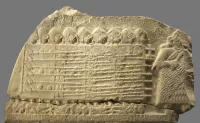The Taj Mahal is an ivory-white marble mausoleum in Agra, India, built by Mughal emperor Shah Jahan in 1631. It was commissioned to house the tomb of his wife, Mumtaz Mahal, and later Shah Jahan himself. The Taj Mahal is the central structure in a 17-hectare complex that includes a mosque, a guest house, and formal gardens enclosed by a crenellated wall.
1908: Restoration Project Completion
In 1908, the restoration project ordered by British viceroy Lord Curzon was completed, with the addition of a large lamp in the interior chamber and the replacement of the gardens with European-style lawns.
1942: Erection of Scaffolding
In 1942, the government erected scaffolding to disguise the building in anticipation of air attacks by the Japanese Air Force.
1947: Responsibility for Maintenance
Since Indian independence in 1947, the Archaeological Survey of India has been responsible for the maintenance of the monument.
1983: UNESCO World Heritage Site Designation
In 1983, the Taj Mahal was designated as a UNESCO World Heritage Site, recognized as "the jewel of Islamic art in India".
1989: Publication of Book
Several court cases and statements by right-wing politicians about Taj Mahal being a Hindu temple have been inspired by P. N. Oak's 1989 book "Taj Mahal: The True Story", in which he claimed it was built in 1155 AD and not in the 17th century.
1997: Establishment of Taj Trapezium Zone
In 1997, following Supreme Court directives, the Indian government established the "Taj Trapezium Zone (TTZ)", a 10,400-square-kilometre area around the monument with strict emissions standards.
2000: Dismissal of Petition
In 2000, India's Supreme Court dismissed P. N. Oak's petition to declare that a Hindu king built the Taj Mahal.
2005: Dismissal of Petition
In 2005, the Allahabad High Court dismissed a petition by Amar Nath Mishra claiming that the Taj Mahal was built by the Hindu king Paramardi in 1196.
2006: Archaeological Reconstruction
In 2006, archaeologists reconstructed part of the pool in the Mehtab Bagh, demonstrating a dark reflection of the white mausoleum.
2007: New Seven Wonders Listing
In 2007, the Taj Mahal appeared in several listings of seven wonders of the modern world, including the New Seven Wonders of the World.
2007: New 7 Wonders of the World
In 2007, the Taj Mahal was declared a winner of the New 7 Wonders of the World initiative.
2010: Cracks appear in parts of the tomb
In 2010, cracks appeared in parts of the tomb due to a decline in the groundwater level in the Yamuna river basin.
November 2015: Statement in Indian Parliament
In November 2015, the Union Minister of Culture stated in the Indian Parliament that there was no evidence that it was ever a temple.
2015: Cost Estimation
In 2015, the estimated cost to build Taj Mahal would be approximately ₹52.8 billion (US$827 million).
August 2017: ASI Declaration
In August 2017, the Archaeological Survey of India declared that there was no evidence to suggest the monument ever housed a temple.
April 2018: Storm Damage
On 11 April 2018, minor damage was reported at the Taj Mahal due to storms.
2019: Implementation of Time Limit and Fines
In 2019, fines were instituted for visitors who stayed longer than three hours, to address overtourism.
May 2020: Storm Damage
On 31 May 2020, minor damage was reported at the Taj Mahal due to storms.
2022: Visitor Count
About five million visitors visited the Taj Mahal in the financial year 2022–23.
2024: Entrance Fees
As of 2024, the Taj Mahal entrance fee for Indian citizens was ₹50, for citizens of SAARC and BIMSTEC countries, it was ₹540 and for other foreign tourists, it was ₹1,100.
2025: Revenue Generation
As per a 2025 government report, the Taj Mahal earned ₹297 crore (US$35 million) over five years, making it the highest-earning ASI monument.
Mentioned in this timeline
India officially the Republic of India is a South Asian...
Pakistan officially the Islamic Republic of Pakistan is a South...

Books are a means of storing information as text or...

War is defined as an armed conflict involving the organized...

A supreme court the court of last resort in many...

Travel involves the movement of people between geographical locations using...
Trending

5 days ago Thanksgiving Dinner Cost Drops in 2025: Survey Reveals Cheaper Meal.
55 minutes ago Republic Services: Meeting Demand, Stock Rating, and Recycling Expansion Value Explored.
56 minutes ago JMU Dukes Triumph Over Omaha Mavericks in Convocation Center Showdown

56 minutes ago Richard Gere and Wife Alejandra Silva Make Rare Red Carpet Appearance in Madrid.
2 hours ago Penny Oleksiak, Olympic Champion, Suspended Two Years for Anti-Doping Rule Violation.
2 hours ago New Jersey American Water Announces 2025 Community Grants; Residents Seek Repairs.
Popular
Aftyn Alyssa Behn is an American politician currently serving as...

William Franklin Graham III commonly known as Franklin Graham is...

Candace Owens is an American conservative political commentator and author...

XXXTentacion born Jahseh Dwayne Ricardo Onfroy was a controversial yet...

Marjorie Taylor Greene known as MTG is a U S...

Cristiano Ronaldo often nicknamed CR is a Portuguese professional footballer...
